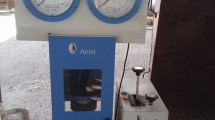Abstract
Four grades of concrete with and without fly ash were devised and tested for compressive strength. The concretes were cured in three different curing regimes. The skin strength of concretes under inadequate curing was calculated by assuming a linear model for the variation of strength, and the strength difference between cement and fly ash concretes has been worked out. The skin strength of cement concretes was found to be higher than that of fly ash concretes. The test results were found to be affected by the size of the test specimen, when proper curing was not provided. The difference in sorptivity of fly ash and cement concretes cured for four days and not provided with any initial curing has been included. For all grades of concrete, the sorptivity of fly ash concrete was found to be marginally higher. The difference in sorptivity between fly ash and cement concretes was observed to increase as the strength of the mix decreased. The effect of initial curing was found to be highly significant. The sorptivity of samples with no curing was twice as much as those with four days initial curing. Besides the material properties, the age and strength of a fly ash concrete were also found to be important factors in determining the cementing efficiency of the fly ash.
Resume
On a calculé et essayé la résistance à la compression de quatre classes de béton avec et sans cendres volantes. On a appliqué à ces bétons trois régimes de conservation différents. On a calculé la résistance de la peau de bétons conservés de façon inadéquate en supposant un modèle linéaire pour la variation de la résistance et la différence de résistance entre le béton de ciment et le béton de cendres volantes. Il est apparu que la résistance de la peau des bétons de ciment était plus élevée que celle de la peau des bétons de cendres volantes et que la taille des éprouvettes influait sur les résultats d'essai en cas de conservation inadéquate. On a inclus la différence d'absorption d'eau entre les bétons de cendres volantes et les bétons de ciment conservés pendant quatre jours sans traitement initial. Pour toutes les classes de béton, les bétons de cendres volantes présentent une supériorité d'absorption d'eau négligeable. On a observé que la différence d'absorption d'eau entre ces deux catégories de béton augmentait quand la résistance du mélange diminuait. L'influence de la conservation initiale s'est révélée très significative. L'absorption d'eau des échantillons non traités était deux fois supérieure à celle des échantillons ayant subi une conservation initiale de quatre jours. Outre les propriétés du matériau, l'âge et la résistance d'un béton de cendres volantes constituent des facteurs importants pour déterminer le coefficient d'efficacité de la cendre volante.
Similar content being viewed by others
References
Smith, I. A., ‘Design of fly ash concrete’,Proc. Inst. Civil Engrs. 36 (1967) 769–791.
Hobbs, D. W., ‘Portland pulverised fuel ash concretes: water demand, 28 day strength, mix design and strength development’,Proc. Inst. Civil Engrs 85 (1988) 317–331.
Gopalan, M. K. and Haque, M. N., ‘Mix design procedure for fly ash concrete’, in Conference on Concrete Symposium, Perth, Australia, 1983, pp. 12–17.
Idem ‘Mix design for optimal strength development of fly ash concrete’,Cement Concr. Res. 19 (1989) 634–641.
Ravina, D. and Mehta, P. K., ‘Properties of fresh concrete containing large amounts of fly ash’,Cement Concr. Res. 16 (1986) 227–238.
Gopalan, M. K. and Haque M. N., ‘Design of fly ash concrete,’Cement Concr. Res. 15 (1985) 694–702.
Gopalan, M. K., ‘Optimum fly ash in structural concrete’, in Proceedings of the Shanghai 1991 Ash Utilisation Conference, Vol. 2.
Ho, D. W. S. and Lewis, R. K., ‘Concrete quality as measured by water sorptivity’,Civil Engng Trans. Inst. Engrs Austr. 26 (1984) 306–313.
Idem ‘The water sorptivity of concretes: the influence of constituents under continuous curing’,Durability Building Mater. 4 (1987) 241–252.
Author information
Authors and Affiliations
Rights and permissions
About this article
Cite this article
Gopalan, M.K. Efficiency, skin strength and sorptivity of fly ash concretes. Materials and Structures 28, 235–240 (1995). https://doi.org/10.1007/BF02473254
Issue Date:
DOI: https://doi.org/10.1007/BF02473254




